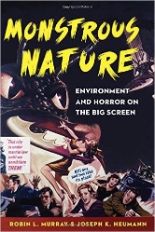
 It took one childhood viewing of William Shatner taking on a small town’s Kingdom of the Spiders to make me an instant, lifelong fan of the horror subgenre of animal-attack films. Widening the scope to nature overall fighting back against an unappreciative and oblivious populace, Robin L. Murray and Joseph K. Heumann explore how these movies reflect how our culture grapples with our uneasy co-existence with flora and fauna, in their new essay collection from University of Nebraska Press, Monstrous Nature: Environment and Horror on the Big Screen. While I was primed for a highbrow take on a lowbrow topic, I was ill-prepared for how much fun it can be.
It took one childhood viewing of William Shatner taking on a small town’s Kingdom of the Spiders to make me an instant, lifelong fan of the horror subgenre of animal-attack films. Widening the scope to nature overall fighting back against an unappreciative and oblivious populace, Robin L. Murray and Joseph K. Heumann explore how these movies reflect how our culture grapples with our uneasy co-existence with flora and fauna, in their new essay collection from University of Nebraska Press, Monstrous Nature: Environment and Horror on the Big Screen. While I was primed for a highbrow take on a lowbrow topic, I was ill-prepared for how much fun it can be.
It’s important, however, to point out what this book is not: a reference guide, a few of which already exist, including William Schoell’s recently reprinted Creature Features: Nature Turned Nasty in the Movies. What it is is a sharply written, fiercely intelligent examination of their subject, which the co-authors approach from 10 angles and on many more films. It is likely the only book in existence that dares to straw a straight line from Darren Aronofsky’s Noah to Troma’s Toxic Avenger series.
Right away, Murray and Heumann surprise with their unique choices for chapters, contrasting the 1971 Oscar-winning documentary The Hellstrom Chronicle, which warns of insects inheriting the earth on an apocalyptic scale, with the 2009 experimental doc Beetle Queen Conquers Tokyo, a look at Japan’s quirky reverence for the bug; in both cases, the insects are ascribed human traits, but only in the former do they represent our worst. From the 1975 William Castle production Bug to 1988’s Roger Corman-produced The Nest, cockroach cinema — able to take a shortcut to present the vermin as evil by exploiting our collective disgust — goes under the microscope as well.
Monstrous Nature is hardly 100 percent insect-driven, as subsequent sections delve into parasites (e.g. Barry Levinson’s 2012 slapdash found-footage project, The Bay) and cannibals (à la Antonio Bird’s 1999 mismarketed flop, Ravenous, which the authors convincingly brand as “feminist”). From comedic takes on toxic waste (Troma’s Class of Nuke ‘Em High franchise) to body-modification tales (the Soska sisters’ American Mary, whose heroine’s actions earn an interesting comparison to the Cyclosa spider), the book is full of discussions that engage the mind as they trigger your six- and eight-legged fears. —Rod Lott
